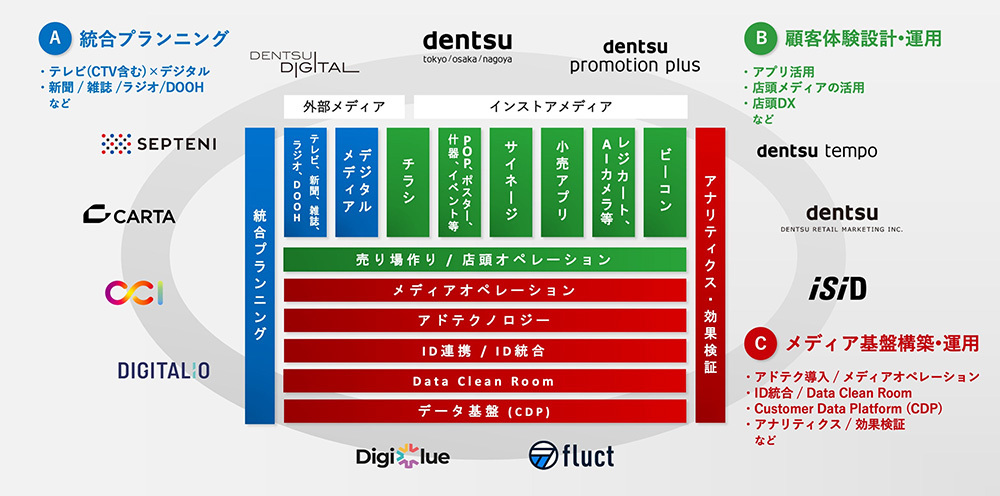Note: This website was automatically translated, so some terms or nuances may not be completely accurate.
The success of Japanese-style retail media lies not in imitating the US. The future envisioned by the Dentsu Group.
※This article is an edited version of an article originally published on November 20, 2023, in "Business Insider Japan".
Dentsu Group, which champions the role of an Integrated Growth Partner (IGP) and aims to be a partner committed to the sustainable growth of client companies and society. As major retailers begin initiatives to develop retail media, the group has launched the cross- functional internal project " dentsu retail unit" to support the establishment of retail media.
" Realizing a win-win-win scenario —enriching consumers' shopping experiences, promoting purchases of client companies' products, and contributing to retailers' sales growth—is our very mission," says Hisashi Matsunaga, Growth Officer at Dentsu Japan, discussing the current state of retail media and the company's initiatives.
Why Major Retailers Are Embarking on Retail Media Development
Retail media, which leverages retailers' own proprietary customer purchase and behavioral data (first-party data) to deliver advertising, is gaining significant attention.
Retailers, where consumers purchase goods, possess media that serve as customer touchpoints: advertising posters and signage in stores, or their own apps and websites. The purpose of retail media is to leverage advertising and promotions using first-party data, primarily purchase data, on these media to drive purchases, build customer relationships, and enhance lifetime value.

"The rise of retail media was significantly driven by the proliferation of smartphone payments, which enabled the collection of purchase data on an ID-based system. While retailers, including physical stores, had long utilized their own media, the increase in captured customer IDs made it possible to track purchasing behavior. This heightened the potential to increase the lifetime value of product purchasers by expanding the range of approachable advertising and promotional products, leading to heightened attention," (Mr. Matsunaga)
Walmart in the U.S. pioneered retail media. Having initiated its omnichannel strategy in 2015, the company achieved approximately $1 billion in retail media advertising revenue by 2020, expanding to $2.7 billion in 2022—a roughly 30% year-over-year increase.
Observing these developments in the U.S. , Japanese companies began entering the retail media space. However, the current situation reveals a growing divergence between the two markets.
In 2022, U.S. retail media sales reached $40.81 billion (approximately ¥5.7 trillion), a scale vastly different from Japan's estimated ¥13.5 billion (CARTA HOLDINGS, INC forecast). However, there are differences in how these figures are defined. In Japan, retail media often refers to advertising on apps or in-store media at physical locations like convenience stores and supermarkets. The ¥13.5 billion figure does not include advertising on e-commerce platforms like Amazon or Rakuten.
In contrast, in the U.S., retail media encompasses not only media from physical stores like Walmart but also sponsored ads on e-commerce platforms, including Amazon. Naturally, including Amazon's digital ads significantly increases the scale. Similarly, if Japan included ads on e-commerce platforms, the retail media market size would exceed ¥260 billion (according to "2022 Japan Advertising Expenditures").
Furthermore, the physical retail environments in Japan and the U.S. differ significantly. In the U.S., physical stores are scattered across vast land areas, unlike Japan where shopping is often done at nearby stores. Consequently, the already high e-commerce penetration rate in the U.S. increased further during the pandemic, widening the gap with Japan. Simply put, U.S. retail media has largely emerged from e-commerce. Japan, with its relatively low e-commerce penetration rate, cannot expect similar results by simply imitating the U.S. model. In 2022, the U.S. e-commerce penetration rate was 27%, while Japan's was about 9%—a gap of roughly threefold," (Mr. Matsunaga)
"Delivering the right message close to the point of purchase" – Japan's unique evolution has begun
The business structures of retail also differ significantly between Japan and the U.S., with the U.S. showing a strong tendency toward oligopolization in each market.
Moreover, in the U.S., companies like Walmart offer benefits such as entertainment services and gas discounts to paid app members, linking the shopping experience with user benefits. This is said to have attracted over 120 million app users. With the ability to approach such a large number of people based on purchase data, it's only natural that client companies increasingly invest funds in advertising and promotions.
In contrast, Japanese retail has not seen the same level of oligopolization as the US, and the sales scale of individual retailers is relatively low. Most retailers have customer IDs in the millions at most, and client companies are not in a position to invest large sums in advertising.
However, some major Japanese retailers, recognizing that while ID-based systems are less developed, many people visit physical stores daily, are implementing ID initiatives. They are adopting strategies to deliver appropriate messages to these customers in locations close to their point of purchase.

"Even without IDs, we can push purchases to customers visiting stores by, for example, offering samples or coupons on the spot, or introducing TV programs featuring the products. Moreover, unlike in the past, millions of people now use apps, making effectiveness verification possible. We can now see how much marketing initiatives contribute even to non-ID-registered visitors. Our experience also shows that advertising and promotional messages at customer touchpoints close to purchase strongly influence buying decisions.
Therefore, retailers need not abandon retail media simply because they lack customer identification. Japan is beginning to chart its own course: advancing customer identification while simultaneously strengthening in-store capabilities and leveraging external media like television and digital advertising. Walmart in the U.S. has also been expanding its market beyond e-commerce and external digital advertising. Over the past year or so, it has begun strengthening its in-store media, such as digital signage installed on product shelves and advertising displayed on self-checkout screens, targeting the estimated 150 to 200 million physical store visitors.
While the ultimate goal of retail media— boosting purchases and lifetime value—remains the same, the approach differs between the U.S. and Japan due to the distinct environments their retail businesses operate in," (Mr. Matsunaga)
What challenges and support are needed when launching retail media?
As companies advance their retail media launches, the Dentsu Group established a cross-group virtual organization in 2020 to provide accumulated insights and capabilities to various stakeholders. This year, it was renewed as the cross-functional internal organization "dentsu retail unit."
"We at the various dentsu Japan companies have been receiving diverse consultations from many retailers on how to sell more products for quite some time, long before the term 'retail media' entered the mainstream. Within the retail media context, it's only natural that strategies differ depending on whether the retailer prioritizes the advertising business, their core product sales, or both. We support each retailer by combining the capabilities of the various dentsu Japan companies to address their specific challenges," said Matsunaga.

"The challenges we consult on generally fall into three categories. The first is primarily CX (Customer Experience) related, such as 'How should we design the customer experience for apps or the in-store shopping experience?'
The second involves supporting clients when they need ad technology (systems that optimize advertising) to handle multiple media and clients. This occurs after confirming results through pilot tests using digital signage and other tools across several to dozens of stores , and they want to scale their efforts.
The third involves television advertising designed to drive customer traffic to stores by combining external digital ads and in-store media distribution to maximize reach. Even though TV ratings in Japan have relatively declined compared to the past, they remain significantly higher than in the US. The power of TV commercials and programs to drive product sales, including in the Tokyo metropolitan area, remains strong. We frequently receive inquiries like, 'We've done everything we can with our stores, so now we want to leverage TV's power,' or 'We can't make large investments in store DX, so we want to strengthen our TV integration.'" (Mr. Matsunaga)
Regarding the first aspect of customer experience design, many cases involve supporting DX transformation through CX innovation. This begins with reviewing app UI/UX, designing customer interactions with products and promotions using retail apps, and developing shelf layouts based on social listening of UGC (user-generated content) from SNS. Additionally, AI cameras measure the results of these customer experiences to inform subsequent experience design.
In-store broadcasts are known to strongly push purchases among visitors. We've received requests like, "We want to convert flyers into in-store broadcasts amid recent staffing shortages. Ideally, we'd like to promote local products using regional dialects rather than standard Japanese." In response, we are promoting the adoption of AI technology developed by the Dentsu Group.
Furthermore, addressing the challenge of "wanting to strengthen e-commerce while reducing the cost of manually creating detailed pages for numerous products," the Dentsu Group is developing a system that automatically generates product detail pages using Generative AI.
Regarding the second area of ad technology adoption, there is significant demand for solutions that centrally manage and deliver ads across external digital media (leveraging purchase data at the ID level, which retailers already have in place ), digital signage, and proprietary apps, while also enabling delivery and effectiveness verification. Dentsu Group has developed the "Retail Ad Manager" to manage ad delivery on retailers' owned media and supports integration with external digital ad delivery systems and digital signage platforms.
Alongside implementing ad technology that enables integrated management for multiple clients placing ads across multiple media and optimizes ad inventory, building a mechanism for effectiveness verification is equally important. Since 2016, the Dentsu Group has advanced the development and utilization of data clean rooms. These secure environments enable integrated analysis of clients' and data holders' first-party data alongside platform operators' licensed data.
In fiscal year 2023, the data cleanroom was utilized in approximately 1,000 client projects. Building on this experience and insights, the Group also developed "TOBIRAS," a system infrastructure that centrally manages analysis and operations across data cleanroom environments provided by multiple platform operators. As retail media gains traction, TOBIRAS is increasingly being adopted by multiple retailers and data holders.
For national brand advertisers to confidently place ads on the emerging retail media landscape, it is essential to establish a verification system ensuring message fairness and compliance with various laws. The Dentsu Group possesses the experience, insights, and organizational structure gained from co-developing the mass advertising and digital advertising markets with media partners. We are committed to actively supporting this domain as well.
Thirdly, we are strengthening collaboration between retail companies and television advertising. We have established a scheme that bridges awareness (customer acquisition) initiatives originating from TV media with sales promotion (purchase) initiatives via retail apps and in-store activities, driving sales growth. The difference from traditional retail campaigns tied to TV ads lies in our focus on integration with retail customer touchpoints, ensuring scalability while enabling verification through purchase data. By accumulating analysis and improvements of campaign responses and purchase responses, the future goal is to build a "predictive model for TV × retail campaigns that optimally contribute to purchases" and to provide efficient services based on this model.

Alongside supporting retailers, clients strongly expect the Dentsu Group, as an advertising and marketing company, to engage in upstream planning. This involves not only formulating brand and target strategies but also determining how much media spend across which channels will achieve total consumer reach, strengthen customer relationships, and ultimately drive product sales.
Our value and role lie in formulating overall marketing strategies using panel data and various survey data that provide a bird's-eye view of the entire market, combined with ID-level purchase data accessible through our partnerships. Based on these strategies, we then create integrated plans that combine multiple retail media, external digital media, television, and other channels to drive product sales.
We can then measure the effectiveness of these efforts using ID-enabled retail media, estimate the impact of the overall marketing activities, and even inform future initiatives for non-ID-enabled retail media." (Mr. Matsunaga)
On the other hand, for consumers, we provide opportunities to encounter products they might not have considered before, through channels like apps, digital signage, or non-digital POP displays. Furthermore, if that person is ID-tracked, we can make recommendations based on customer journey hypotheses, creating opportunities to discover new products.
"Through our proprietary research at Dentsu Group, we have identified product categories with high unplanned purchase rates in stores and gained insights into the factors driving purchase decisions for those categories.
For example, by analyzing past purchase history, we can target customers who have never purchased items in a certain category. For categories where price is a key factor, we can offer coupons with high discount rates or sampling initiatives. For categories where product content is more important, we can deliver information highlighting the product's appeal, even if the discount rate is lower.
In addition to these product-specific, customer ID-level promotional measures, creating a sense of security and trust through repeated exposure via TV commercials and digital ads enables demand creation through new customer acquisition." (Mr. Matsunaga)
Through appropriate recommendations encompassing not only retail media but also mass media like television, consumers enrich their shopping experiences, manufacturers increase customer lifetime value, and retailers boost foot traffic and sales. Mr. Matsunaga emphatically stated that the Dentsu Group's role is to provide "concrete, client-centric support" to build this "win-win-win" relationship.
However, Matsunaga added that this domain cannot be achieved by the Dentsu Group alone. It requires collaboration among various players, including media owners (retail businesses), diverse data holders, platform operators, wholesalers, technology companies, and system integrators (SIers).
(Business Insider Japan Brand Studio)
Was this article helpful?
Newsletter registration is here
We select and publish important news every day
For inquiries about this article
Author

Hisashi Matsunaga
Dentsu Group Inc.
dentsu Japan Growth Officer
After joining Dentsu Inc., he worked on planning and consulting for client companies utilizing data, as well as developing Dentsu Inc.'s planning systems. He was involved in numerous new business development initiatives with media companies, retailers, and digital platform operators. From 2016, he worked at the Dentsu Data & Technology Center, responsible for formulating Dentsu Inc.'s data strategy and developing its data infrastructure. In 2023, he was appointed Growth Officer/Chief Data Officer at Dentsu Japan. He is responsible for formulating Dentsu Japan's data strategy, forming alliances with data holders and digital platform operators, and developing solutions and products leveraging data and technology (Ph.D. in Engineering).


